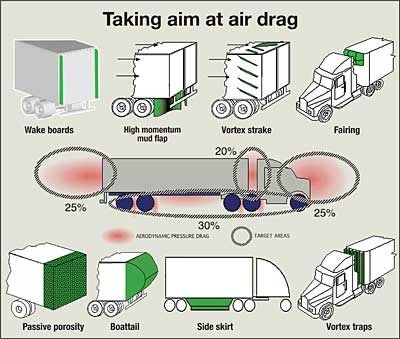Fuel Mileage Slope Nose Vs Conventional Nose
Topic 2243 | Page 1

Honestly there are so many variables when it comes to fuel effecnent trucks. Can be literally hundreds of different combos. The older most classic looking trucks do not get good fuel mileage to the the bid square fronted hood. A lot of flat surface for wind to hit.
Yap, wind resistance is a massive hindrance to fuel mileage. Not only the slope of the nose but things like the slope and height of the sleeper, how much air gets under the front bumper of the truck, how much wind gets under the trailer, how much room there is in between the cab and the trailer (more space means more turbulence), whether or not you have snow or ice on top of the trailer, and things like that.
And of course because wind resistance is such a hindrance to fuel mileage so is the speed you travel. I can't remember the numbers now but I think they say for every mile per hour above 50 you lose 1/10th of a mile per gallon - something like that. That's why companies nowadays have their trucks governed so low - many of them in the 57-62 mph range.

I understand there are many things that effect fuel mileage. I was wondering if there was any numbers out there on just the different style front ends of the trucks. It has to help to have the slope nose, it just makes sense. There are a lot of different fuel saving products out there and I am sure some are worth the investment and some are not. I also wonder about the big wing you see on the top of trucks. It looks really cool but I wonder if it diverts enough wind over the trailer to out way the increased down force and drag it creates. Is there a set distance on the best distance the front of the trailer should be from the back of the truck? I know the type of trailer would change this but is there a way to know if you are pulling a van it should be set at this spacing?
I don't expect any of us here are going to be able to help with those kind of specifics.
HOS:
Hours Of Service
HOS refers to the logbook hours of service regulations.
Aerodynamic drag and tire rolling resistance:

Aerodynamic drag on a semi truck:

and here:

So a general answer to your question would be that the nose of a semi causes about 25% of the overall aerodynamic drag, and that sloped or not it is still going to cause about the same drag due to its height and width, the windshields slope, things sticking out like mirrors, and many other factors, though a sloped nose might lessen the drag slightly, its not going to make a huge difference.
Now making it round and slippery like :

May do more for drag than merely sloping the hood a little.
Phil
New Reply:
New! Check out our help videos for a better understanding of our forum features

















Preview:








 TT On Facebook
TT On Facebook
I would like to know what kind of fuel savings a truck with a slope nose would get over a truck with a regular front end. If you have the same make of truck with the same motor and same transmission and same driver is there a big difference between the two types of front ends. I love the look of a classic style but with fuel costs being so much is that type of truck a thing of the past? Thanks for taking the time to read my question.